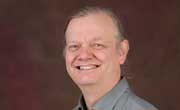Stan Williams

Director, Memristor Research Group
Palo Alto
Biography
Stan Williams is an HP Senior Fellow and director of the Memristor Research group at HP Labs.
He is currently focused on developing technology that supports the concept of CeNSE: The Central Nervous System for the earth. The idea is that nanotechnology has the potential to revolutionize human interaction with the earth as profoundly as the Internet has revolutionized personal and business interaction.
Prompted by his exploration of the fundamental limits of information and computing, Williams recently completed extensive research in nano-electronics and nano-photonics.
For the past 30 years, his primary scientific research has been in the areas of solid-state chemistry and physics and their applications to technology. This evolved into the areas of nanostructures and chemically assembled materials, with an emphasis on the thermodynamics of size and shape.
Williams has been awarded more than 60 U.S. patents, published more than 300 papers in reviewed scientific journals and presented hundreds of invited plenary, keynote and named lectures at international scientific, technical and business events.
He has received numerous awards for business, scientific and academic achievement. Most recently he received the prestigious 2007 Glenn T. Seaborg Medal awarded by the UCLA Department of Chemistry and Biochemistry.
He was named to the inaugural Scientific American 50 Top Technology leaders in 2002 and then again in 2005 (the first to be so named twice). In 2005, Small Times magazine named the U.S. patent collection Williams has assembled at HP as the world’s top nanotechnology intellectual property portfolio and in 2000, MIT’s Technology Review placed one of his patents among the top 5 that “will transform business and technology.”
Williams received a bachelor of arts in chemical physics in 1974 from Rice University and a Ph.D. in physical chemistry from the University of California, Berkeley in 1978. He was a member of technical staff at AT&T Bell Labs from 1978 to 1980 and a faculty member of the Chemistry Department at UCLA from 1980 to 1995.
Research interests
For the past 30 years, Stan's primary scientific research has been in the areas of solid-state chemistry and physics and their applications to technology. This evolved into the areas of nanostructures and chemically assembled materials, with an emphasis on the thermodynamics of size and shape.
Publications
Stan has published more than 300 papers in reviewed scientific journals and presented hundreds of invited plenary, keynote and named lectures at international scientific, technical and business events.
Editor, Nanotechnology Research Directions: IWGN Workshop Report (Vision for Nanotechnology R&D in the Next Decade, M. C. Roco, R. S. Williams and P. Alivisatos, eds., September 1999). Published by the National Science and Technology Council and available at www.nano.gov and also by Kluwer Academic Publishers, ISBN 0-7923-6220-9, 2000). This report led to the National Nanotechnology Initiative, and was adopted by the Office of the President as part of the US fiscal year 2001 budget, and subsequently approved by Congress for funding at $422M in fiscal year 2001 and at $518M in fiscal 2001.
Awards
HP Senior Fellow
HP Fellows are pioneers in their fields, setting the standards for technical excellence and driving the direction of research in their respective disciplines.
Glenn T. Seaborg Medal, UCLA Department of Chemistry and Biochemistry
For exceptional scientific contributions in the field of nanotechnology (2007)
Julius Springer Prize for Applied Physicsw
For outstanding achievements in the area of nanoscience and nanotechnology and its applications (2000)
Feynman Prize in Nanotechnology, Foresight Nanotech Institute
Nanotechnology's highest honor, awarded to Stan and Phil Kuekes for building a molecular switch (2000)
Scientific American 50 Top Technology Leaders
Stan was the first to be named twice to this list (2002 and 2005)
Professional Activities
- Past chair of ACM Special Interest Group on Computer Archictecture (SIGARCH)
- ACM Council and on the Computing Research Association (CRA) board
- Editorial board of Communications of the ACM and IEEE Computer Architecture Letters
Patents
More than 60 U.S. patents, including one selected as among the top 5 patents that "will transform business and technology" by MIT Technology Review in 2000.